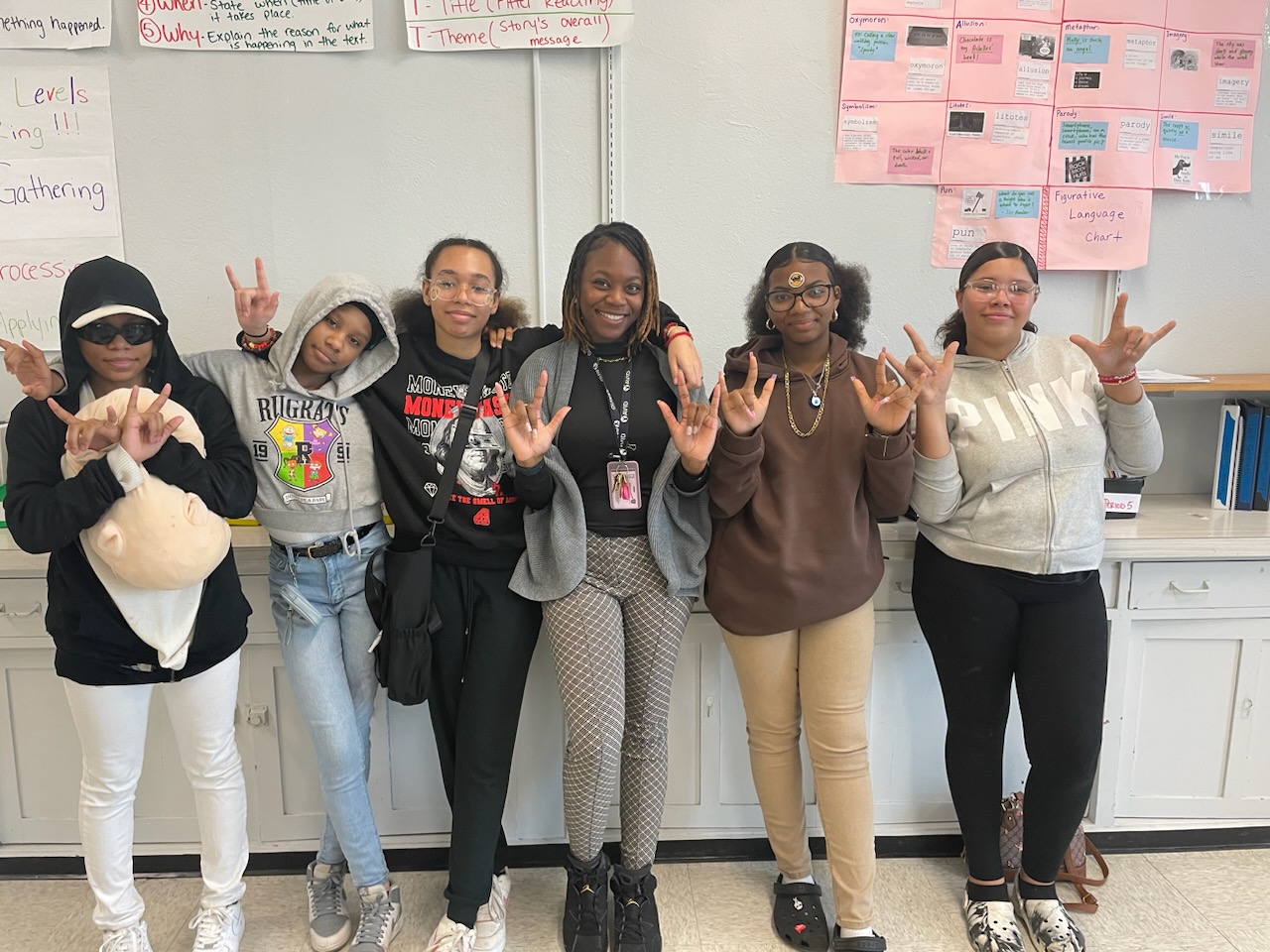Hearing through Hands: Syracuse STEM at Blodgett ASL Club Helps Students Learn the Language of Inclusion
 Syracuse STEM at Blodgett 8th grader Toya Lemons brings one pointer finger in to meet her other pointer finger.
Syracuse STEM at Blodgett 8th grader Toya Lemons brings one pointer finger in to meet her other pointer finger.‘Goals,’ she signed in American Sign Language (ASL).
Toya’s goal is to one day become a Forensic Scientist. But this year, two to three days each week, she’s spending her school lunch period in 8th grade ELA teacher (and building Diversity, Equity, and Belonging Leader) Leeza Roper’s classroom, practicing sign language with her peers.
Through an American Sign Language club – new this year – Ms. Roper, who is fluent in ASL herself, is helping students learn conversational sign.
As the meetings begin, students review the alphabet and their recent ASL vocabulary. Then, they converse with each other – trying out words and phrases they remember.
“I want to learn sign language in case I meet a deaf person,” Teniesha Fallings said as she practiced her signs. “I could say hi, what’s your name… it would make me feel good to be able to make someone feel included. It’s not hard to learn if you pay attention and practice, and Ms. Roper makes it easy because of how she teaches us. The hardest part for me has been remembering individual letters!”
Identity, college, school, skills, opportunities, enjoy, education, multicultural… these are all words that students are able to recall quickly as they sign to each other.
“First and foremost, this experience allows them to be more culturally aware,” Ms. Roper shared. “It helps them understand that language is not always oral. They see that ASL is still a legit language with its own rules and intricacies. It has a different grammatical order than English, allowing them to look at language in a different way. I’m proud that, through this group, they have access to understanding more about deaf culture. I think they look at hearing in a different way now. It allows them to know their privilege and understand things that a lot of adults don’t even understand about deaf people.”
8th grader Tajin'arie Sheppard said that new understanding was one of the reasons she was drawn to the group in the first place.
“I joined this group because sign language has always been a language I wanted to learn,” Tajin'arie said. “My best friend is fluent in it, and we have lots of hearing-impaired friends, so I wanted to be able to communicate with them better. I’ve learned how to do basic things like greetings, letters, and phrases. My friends are happy I’m trying to learn, because they want to be able to communicate with me directly – not with my friend as a translator! I’m hoping to get better at ASL so I can at least understand them more and be able to share more with them. It’s an important group for any school to offer, because opportunities like this aren’t normally available. As a student, I knew I had to take advantage of the opportunity. I can use this opportunity for my own benefit and the benefit of others!”
Nasiana Jones – for whom ASL will be her third language – said a good portion of her family on her dad’s side are deaf, so she’s excited to be able to communicate with them more. Toya Lemons could relate.
“During summer school, Ms. Roper taught me some ASL, and I found it so interesting,” Toya explained. “My cousin is deaf, and I thought it would be cool to learn so I can help communicate with him and make him feel more included. A lot of people don’t know ASL, and it’s a great experience to learn it! It’s a fun way if you don’t socialize much to get out of your comfort zone and become more aware of other people and what they’re experiencing.”
Valana Wheat said she sees the club as a way to set her ahead in college and in a career – noting the variety of skills and backgrounds applicants have and how ASL is a unique skill to help set her apart. Ms. Roper said she already sees how signing is opening new avenues for her students.
“ASL has become a great way for them to communicate,” she noted. “They don’t always have to use spoken language. They’re saying good morning & good afternoon with each other in sign. It’s something they’re being more intentional about. I exposed them to the language, but now they’re finding their own ways to implement it!”
Moving forward, Ms. Roper hopes to expand the group beyond the Syracuse STEM at Blodgett school walls… looking into organizing a field trip to visit an OCC ASL class taught by deaf professors, or inviting OCC students and professors from the program to do a workshop with her ASL group. She also hopes to see more students working toward earning the New York State Seal of Biliteracy in American Sign Language – something a few of her students are already working toward.
To earn the Seal, students would have to complete a paper and then give a presentation using ASL, so they have been noting key vocabulary from each question in a Seal of Biliteracy packet. They’ve also been working with 8th grade English as a New Language (ENL) teacher Alysha Bates to complete some creative projects to show their ASL knowledge.
Way to go, Syracuse STEM scholars… we’re proud of your language learning!


